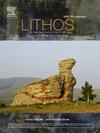Timing and petrogenesis of late orogenic calc-alkaline volcanism in the Slovak Transcarpathians: Implications for the evolution of the Carpathian collisional process
IF 2.9
2区 地球科学
Q2 GEOCHEMISTRY & GEOPHYSICS
引用次数: 0
Abstract
This contribution presents bulk-rock geochemical data with Sr-Nd-Hf isotopes and LA-ICP-MS U-Pb zircon geochronology for volcanic rocks from the Slanské Vrchy Mountains (E-Slovakia), a c. 50 km long volcanic chain located at the western flank of the Miocene Transcarpathian Basin System. The studied volcanics are represented by calc-alkaline andesites and dacites. More mafic composition was only found in a basaltic andesite enclave. Robust concordant U-Pb zircon ages for andesites (n = 6) and dacites (n = 3) range from 12.3 Ma to 11.8 Ma, indicating quasi-contemporaneous post-collisional volcanism. The basaltic andesite, andesites, and dacites have overlapping and correlated isotopic compositions (87Sr/86Sr(12Ma) = 0.7071 to 0.7104, εNd(12Ma) = −7.0 to −1.0, and εHf(12 Ma) = −6.2 to +2.8), which reflect mantle-crust interaction. A general lack of clear correlations between fractionation indicator SiO2 and isotope ratios as well as overlapping isotopic compositions of the andesites and dacites preclude simple coupled assimilation fractional crystallization (AFC) processes. Furthermore, the overall paucity of inherited zircons indicates limited assimilation at upper crustal levels. Pyroxene geothermobarometry points to a complex transcrustal volcanic system, which most likely involved processes of mixing, assimilation, storage, and homogenization (MASH) in the lower crust. Initial melt generation in the mantle was probably triggered by mantle upwelling in a generally extensional tectonic regime, but details on the nature of the mantle source remain enigmatic.
求助全文
约1分钟内获得全文
求助全文
来源期刊

Lithos
地学-地球化学与地球物理
CiteScore
6.80
自引率
11.40%
发文量
286
审稿时长
3.5 months
期刊介绍:
Lithos publishes original research papers on the petrology, geochemistry and petrogenesis of igneous and metamorphic rocks. Papers on mineralogy/mineral physics related to petrology and petrogenetic problems are also welcomed.
 求助内容:
求助内容: 应助结果提醒方式:
应助结果提醒方式:


